Light Increases Astaxanthin Absorbance in Acetone Solution through Isomerization Reactions
Abstract
1. Introduction
2. Results
2.1. Spectrometric Analysis of Astaxanthin
2.2. HPLC Analysis of Astaxanthin
3. Discussion
4. Materials and Methods
4.1. Selected Astaxanthin Oleoresin Batches
4.2. UV/Vis Spectrometric Analysis
4.3. HPLC Analysis
4.3.1. Astaxanthin and Apocarotenal Stock Solutions Preparation
4.3.2. Enzymatic Hydrolysis of Astaxanthin Esters
4.3.3. Extraction of Hydrolyzed Astaxanthin and Preparation of Samples for HPLC
4.3.4. HPLC Analysis Design
4.3.5. Astaxanthin Level Calculation
4.3.6. Characteristics of the Chromatographic System
4.4. Statistical Analysis
5. Conclusions
Author Contributions
Funding
Institutional Review Board Statement
Informed Consent Statement
Data Availability Statement
Acknowledgments
Conflicts of Interest
Sample Availability
References
- Alugoju, P.; Krishna Swamy, V.K.D.; Anthikapalli, N.V.A.; Tencomnao, T. Health Benefits of Astaxanthin against Age-Related Diseases of Multiple Organs: A Comprehensive Review. Crit. Rev. Food Sci. Nutr. 2022; online ahead of print. [Google Scholar] [CrossRef]
- Cao, Y.; Yang, L.; Qiao, X.; Xue, C.; Xu, J. Dietary Astaxanthin: An Excellent Carotenoid with Multiple Health Benefits. Crit. Rev. Food Sci. Nutr. 2021; online ahead of print. [Google Scholar] [CrossRef]
- Stachowiak, B.; Szulc, P. Astaxanthin for the Food Industry. Molecules 2021, 26, 2666. [Google Scholar] [CrossRef] [PubMed]
- Shah, M.M.R.; Liang, Y.; Cheng, J.J.; Daroch, M. Astaxanthin-Producing Green Microalga Haematococcus Pluvialis: From Single Cell to High Value Commercial Products. Front. Plant Sci. 2016, 7, 531. [Google Scholar] [CrossRef] [PubMed]
- Viazau, Y.V.; Goncharik, R.G.; Kulikova, I.S.; Kulikov, E.A.; Vasilov, R.G.; Selishcheva, A.A. E/Z Isomerization of Astaxanthin and Its Monoesters in Vitro under the Exposure to Light or Heat and in Overilluminated Haematococcus Pluvialis Cells. Bioresour Bioprocess 2021, 8, 55. [Google Scholar] [CrossRef]
- Bjerkeng, B.; Hatlen, B.; Jobling, M. Astaxanthin and Its Metabolites Idoxanthin and Crustaxanthin in Flesh, Skin, and Gonads of Sexually Immature and Maturing Arctic Charr (Salvelinus Alpinus (L.)). Comp. Biochem. Physiol. B Biochem. Mol. Biol. 2000, 125, 395–404. [Google Scholar] [CrossRef]
- Higuera-Ciapara, I.; Felix-Valenzuela, L.; Goycoolea, F.M.; Argüelles-Monal, W. Microencapsulation of Astaxanthin in a Chitosan Matrix. Carbohydr. Polym. 2004, 56, 41–45. [Google Scholar] [CrossRef]
- Orosa, M.; Franqueira, D.; Cid, A.; Abalde, J. Analysis and Enhancement of Astaxanthin Accumulation in Haematococcus Pluvialis. Bioresour. Technol. 2005, 96, 373–378. [Google Scholar] [CrossRef]
- López-Cervantes, J.; Sánchez-Machado, D.I.; Gutiérrez-Coronado, M.A.; Rios-Vázquez, N.J. Quantification of Astaxanthin in Shrimp Waste Hydrolysate by HPLC. Biomed. Chromatogr. 2006, 20, 981–984. [Google Scholar] [CrossRef] [PubMed]
- Lu, M.; Zhang, Y.; Zhao, C.; Zhou, P.; Yu, L. Analysis and Identification of Astaxanthin and Its Carotenoid Precursors from Xanthophyllomyces Dendrorhous by High-Performance Liquid Chromatography. Z. Nat.-Sect. C J. Biosci. 2010, 65, 489–494. [Google Scholar] [CrossRef] [PubMed]
- Astaxanthin Esters. Dietary Supplement Monographs. In The United States Pharmacopeia USP42, the National Formulary NF37; United States Pharmacopeia: Rockville, MD, USA, 2019. [Google Scholar]
- Ranga, R.; Sarada, A.R.; Baskaran, V.; Ravishankar, G.A. Identification of Carotenoids from Green Alga Haematococcus Pluvialis by HPLC and LC-MS (APCI) and Their Antioxidant Properties. J. Microbiol. Biotechnol. 2009, 19, 1333–1341. [Google Scholar] [CrossRef] [PubMed]
- Yuan, J.P.; Chen, F. Isomerization of Trans-Astaxanthin to Cis-Isomers in Organic Solvents. J. Agric. Food Chem. 1999, 47, 3656–3660. [Google Scholar] [CrossRef]
- Yang, C.; Zhang, L.; Zhang, H.; Sun, Q.; Liu, R.; Li, J.; Wu, L.; Tsao, R. Rapid and Efficient Conversion of All-E-Astaxanthin to 9Z- and 13Z-Isomers and Assessment of Their Stability and Antioxidant Activities. J. Agric. Food Chem. 2017, 65, 818–826. [Google Scholar] [CrossRef]
- Yuan, J.P.; Chen, F. Kinetics for the Reversible Isomerization Reaction of Trans-Astaxanthin. Food Chem. 2001, 73, 131–137. [Google Scholar] [CrossRef]
- Molnár, P. Research of the (E/Z)-Isomerization of Carotenoids in Pécs since the 1970s. Arch. Biochem. Biophys. 2009, 483, 156–164. [Google Scholar] [CrossRef] [PubMed]
- Zechmeister, L. Cis-Trans Isomerization and Stereochemistry of Carotenoids and Diphenyl-Polyenes. Chem. Rev. 1944, 34, 267–344. [Google Scholar] [CrossRef]
- Koopmann, I.K.; Kramer, A.; Labes, A. Development and Validation of Reliable Astaxanthin Quantification from Natural Sources. PLoS ONE 2022, 17, e0278504. [Google Scholar] [CrossRef] [PubMed]
- Yu, W.; Liu, J. Astaxanthin Isomers: Selective Distribution and Isomerization in Aquatic Animals. Aquaculture 2020, 520, 734915. [Google Scholar] [CrossRef]
- Commission Implementing Regulation (EU) 2017/2470 of 20 December 2017 Establishing the Union List of Novel Foods in Accordance with Regulation (EU) 2015/2283 of the European Parliament and of the Council on Novel Foods. Available online: https://eur-lex.europa.eu/eli/reg_impl/2017/2470/oj (accessed on 30 December 2017).
- Scientific Opinion on the Safety of Astaxanthin-Rich Ingredients (AstaREAL A1010 and AstaREAL L10) as Novel Food Ingredients. EFSA J. 2014, 12, 3757. [CrossRef]
- Honda, M.; Murakami, K.; Zhang, Y.; Goto, M. Rapid and Continuous Astaxanthin Isomerization in Subcritical Ethanol. Ind. Eng. Chem. Res. 2021, 60, 14060–14068. [Google Scholar] [CrossRef]
- Casella, P.; Iovine, A.; Mehariya, S.; Marino, T.; Musmarra, D.; Molino, A. Smart Method for Carotenoids Characterization in Haematococcus Pluvialis Red Phase and Evaluation of Astaxanthin Thermal Stability. Antioxidants 2020, 9, 422. [Google Scholar] [CrossRef]
- Honda, M.; Sowa, T.; Kawashima, Y. Thermal- and Photo-Induced Isomerization of All-E- and Z-Isomer-Rich Xanthophylls: Astaxanthin and Its Structurally-Related Xanthophylls, Adonirubin, and Adonixanthin. Eur. J. Lipid Sci. Technol. 2020, 122, 1900462. [Google Scholar] [CrossRef]
- de Bruijn, W.J.C.; Weesepoel, Y.; Vincken, J.P.; Gruppen, H. Fatty Acids Attached to All-Trans-Astaxanthin Alter Its Cis-Trans Equilibrium, and Consequently Its Stability, upon Light-Accelerated Autoxidation. Food Chem. 2016, 194, 1108–1115. [Google Scholar] [CrossRef] [PubMed]
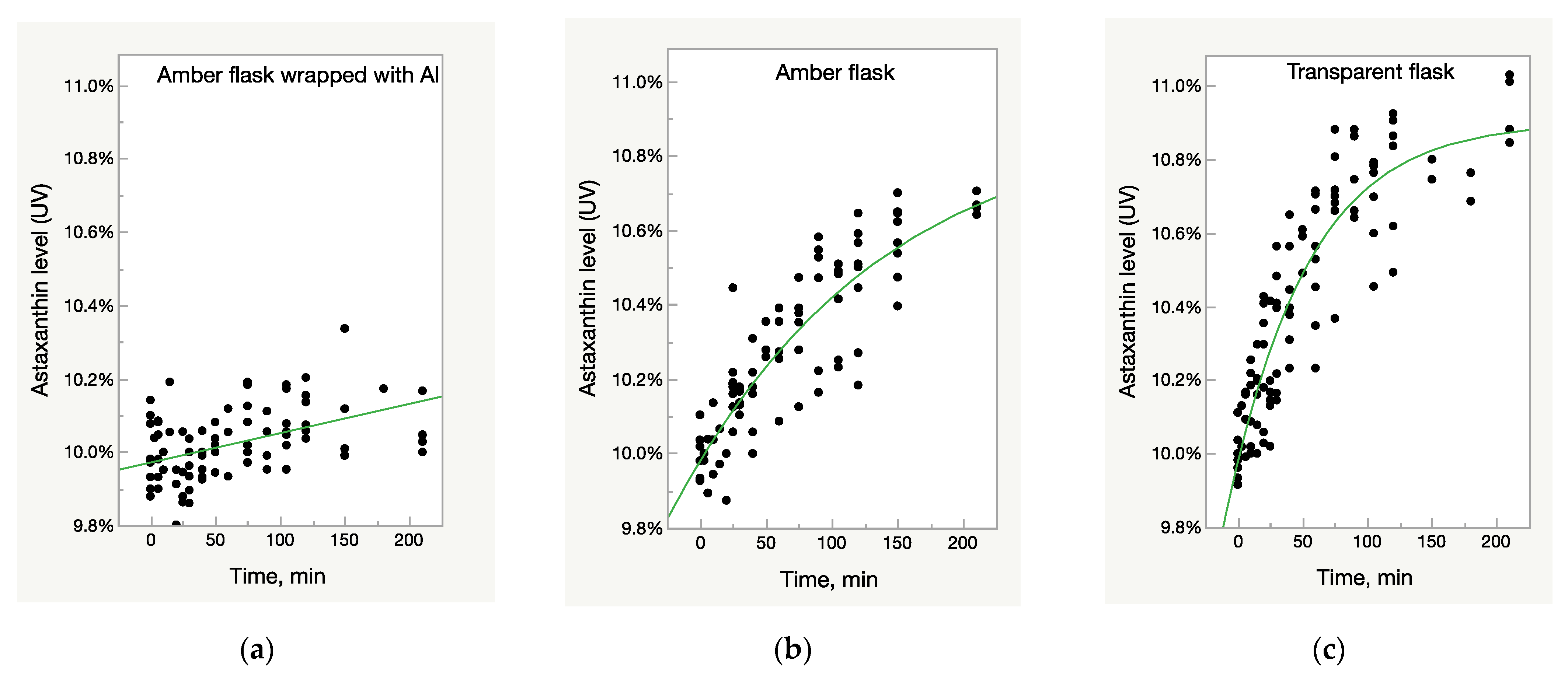

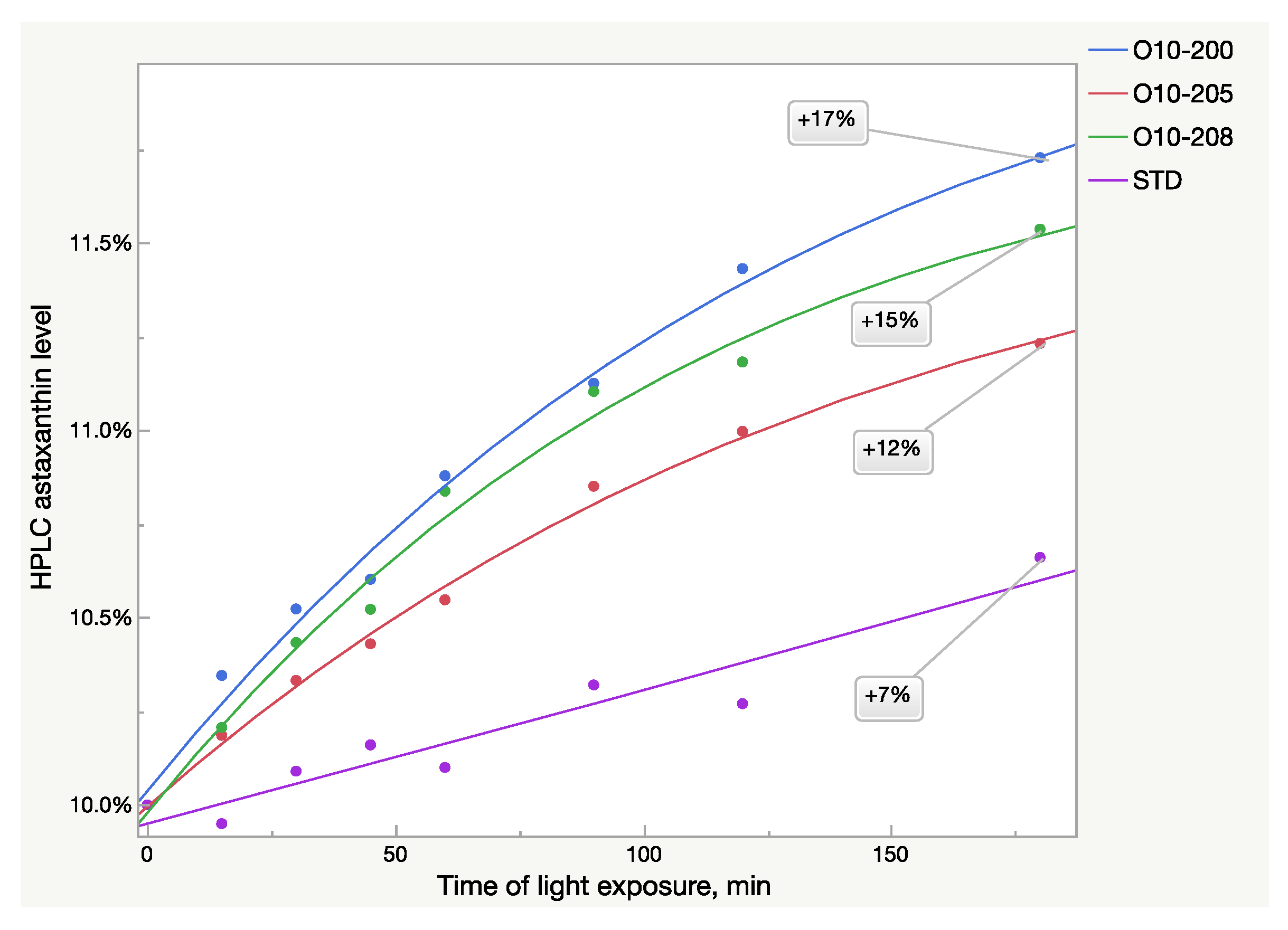
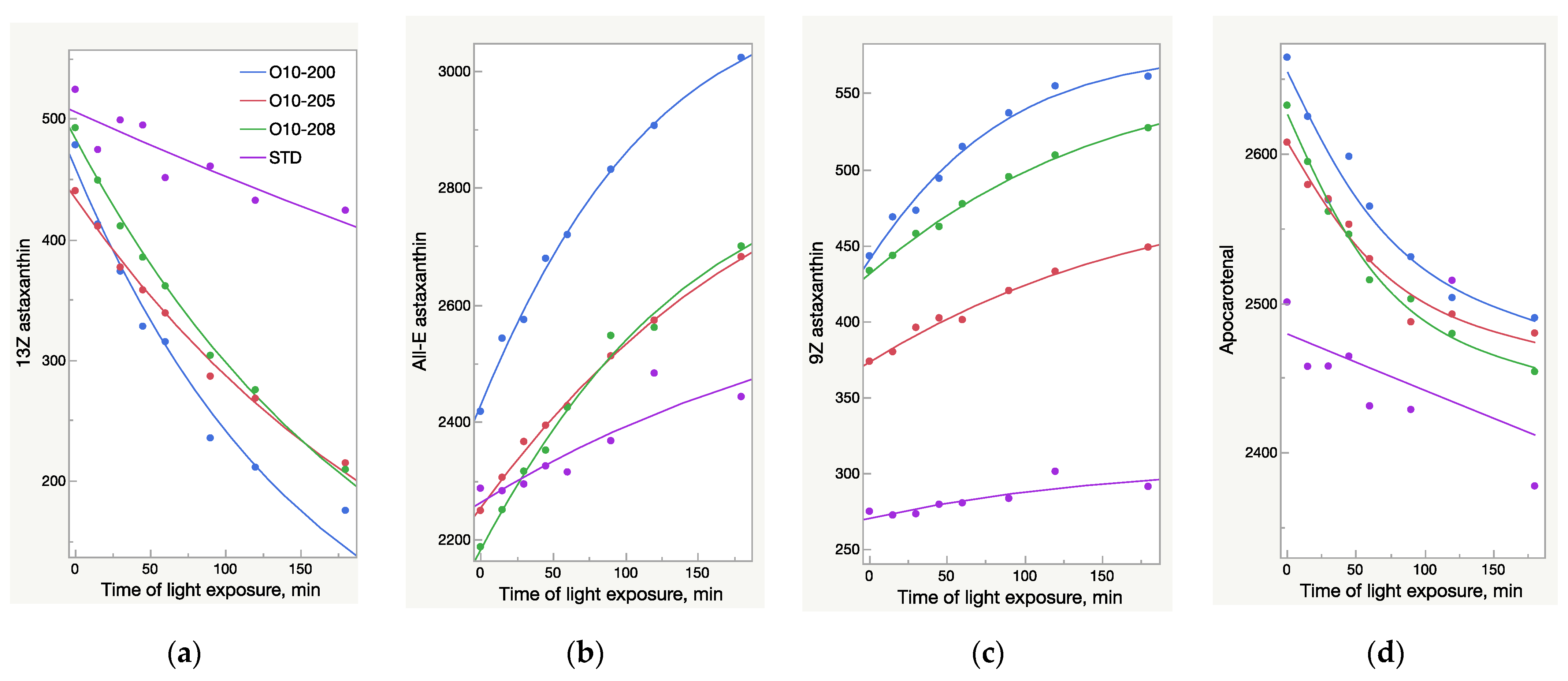
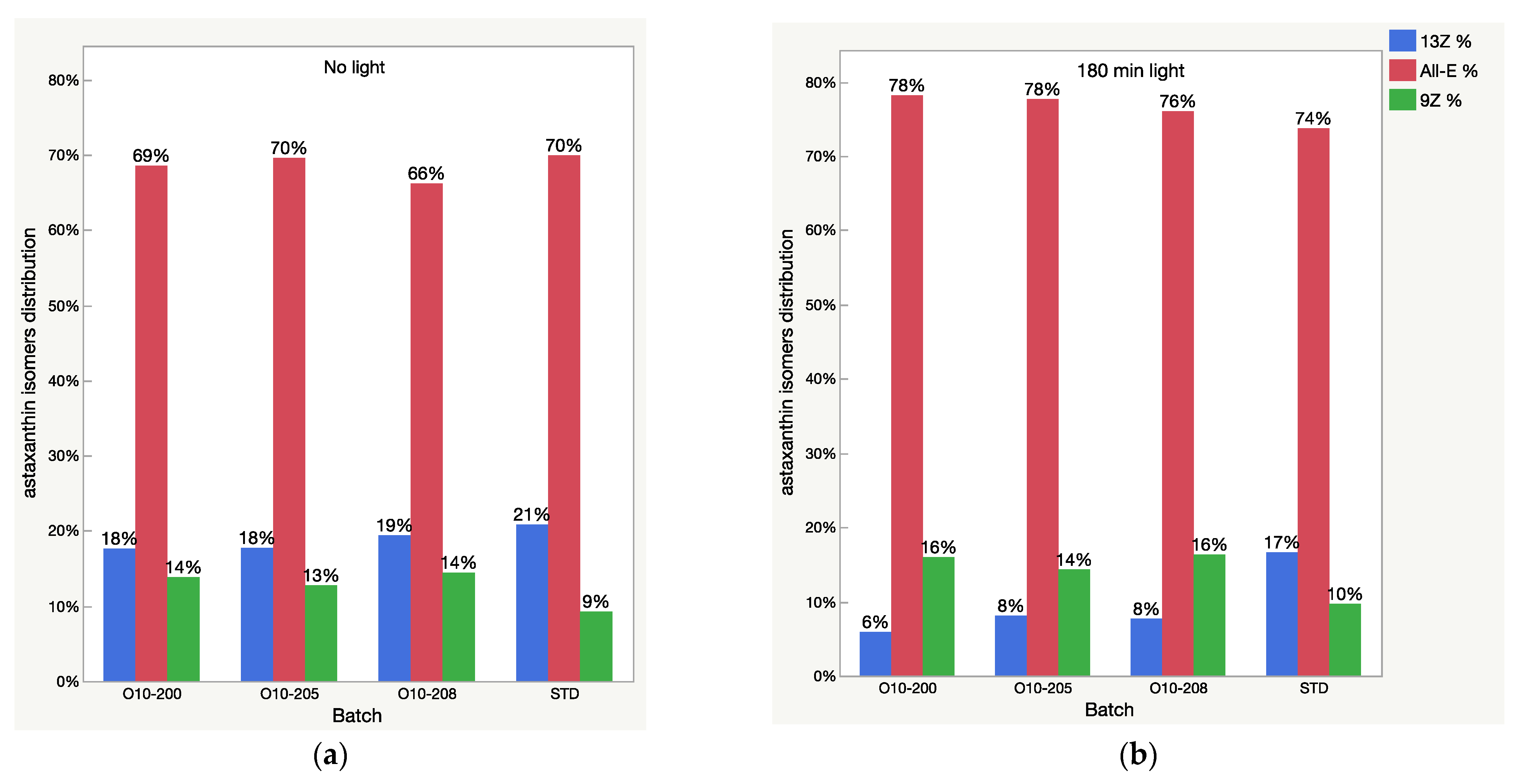


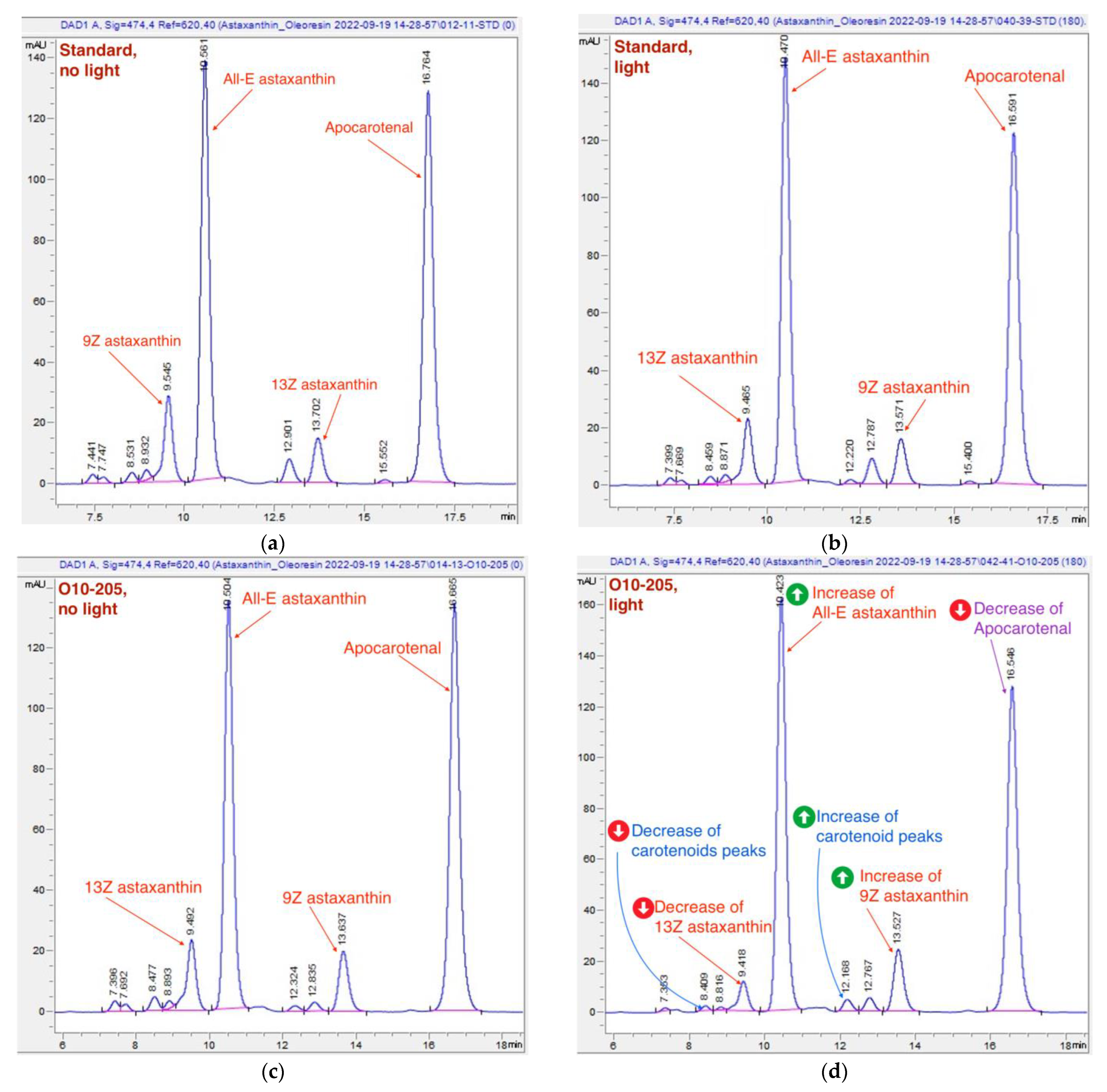
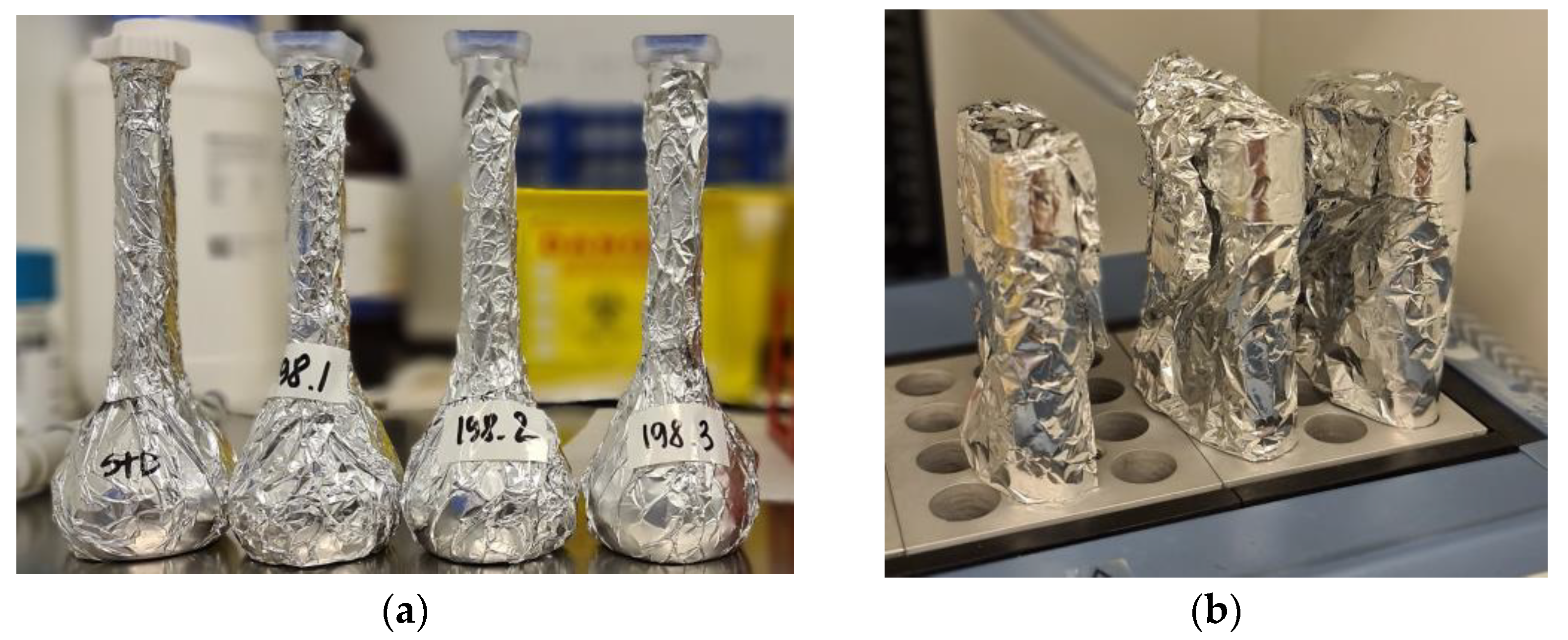
| Curve Parameters | Amber Glass Flask | Clear Glass Flask |
|---|---|---|
| a | 0.007 * | 0.017 ** |
| b | −343.2 ** | −139.6 ** |
| c | 0.1090 ** | 0.1090 ** |
| Curve Parameters | Amber Glass Flask | Clear Glass Flask | ||||||
|---|---|---|---|---|---|---|---|---|
| O10-200 | O10-205 | O10-208 | Standard | O10-200 | O10-205 | O10-208 | Standard | |
| a | 0.011 ** | 0.009 ** | 0.008 ** | 0.0003 & | 0.026 ** | 0.011 ** | 0.019 ** | 0.007 * |
| b | −222.3 ** | −266.4 ** | −302.4 ** | 6077.5 & | −98.7 ** | −183.5 ** | −115.8 ** | −322.0 ** |
| c | 0.1086 ** | 0.1080 ** | 0.1084 ** | 0.7760 & | 0.1084 ** | 0.1119 ** | 0.1107 ** | 0.1109 * |
| Curve Parameters | Clear Glass Flask | |||
|---|---|---|---|---|
| O10-200 | O10-205 | O10-208 | Standard | |
| a | 0.009 * | 0.008 * | 0.010 * | 0.0003 & |
| b | −169.1 * | −220.3 * | −162.3 * | 7753.4 & |
| c | 0.1224 * | 0.1169 * | 0.1186 * | 1.8671 & |
| Lot | Main Components | UV, % | HPLC, % | UV/HPLC, % |
|---|---|---|---|---|
| USP reference astaxanthin standard, lot R120D0 | Algal oleoresin 1 | 10.3 | 10.0 2 | 103.0% |
| Sigma apocarotenal standard, lot BCCF4518 | Trans-β-Apo-8′-carotenal | NA | 97.7 2 | NA |
| O10-200 | Algal oleoresin 1 (73%), Sunflower Oil (27%) | 10.77 | 10.07 3 | 107.0 |
| O10-205 | Algal oleoresin 1 (63%), Sunflower Oil (36%) | 10.34 | 10.17 3 | 101.7 |
| O10-208 | Algal oleoresin 1 (83%), Sunflower Oil (17%) | 10.55 | 10.06 3 | 104.9 |
| Line No. | Sample Code | Description |
|---|---|---|
| 1 | Apo(0) | Apocarotenal sample, no-light |
| 2 | Apo(15) | Apocarotenal sample, 15 min light exposure |
| 3 | Apo(30) | Apocarotenal sample, 30 min light exposure |
| 4 | Apo(45) | Apocarotenal sample, 45 min light exposure |
| 5 | Apo(60) | Apocarotenal sample, 60 min light exposure |
| 6 | Apo(90) | Apocarotenal sample, 90 min light exposure |
| 7 | Apo(120) | Apocarotenal sample, 120 min light exposure |
| 8 | Apo(180) | Apocarotenal sample, 180 min light exposure |
| 9 | STD(0) | USP reference standard, no-light |
| 10 | O10-200(0) | Astalíf 10, O10-200, no-light |
| 11 | O10-205(0) | Astalíf 10, O10-205, no-light |
| 12 | O10-208(0) | Astalíf 10, O10-208, no-light |
| 13 | STD(15) | USP reference standard, 15 min light exposure |
| 14 | O10-200(15) | Astalíf 10, O10-200, 15 min light exposure |
| 15 | O10-205(15) | Astalíf 10, O10-205, 15 min light exposure |
| 16 | O10-208(15) | Astalíf 10, O10-208, 15 min light exposure |
| 17 | STD(30) | USP reference standard, 30 min light exposure |
| 18 | O10-200(30) | Astalíf 10, O10-200, 30 min light exposure |
| 19 | O10-205(30) | Astalíf 10, O10-205, 30 min light exposure |
| 20 | O10-208(30) | Astalíf 10, O10-208, 30 min light exposure |
| 21 | STD(45) | USP reference standard, 45 min light exposure |
| 22 | O10-200(45) | Astalíf 10, O10-200, 45 min light exposure |
| 23 | O10-205(45) | Astalíf 10, O10-205, 45 min light exposure |
| 24 | O10-208(45) | Astalíf 10, O10-208, 45 min light exposure |
| 25 | STD(60) | USP reference standard, 60 min light exposure |
| 26 | O10-200(60) | Astalíf 10, O10-200, 60 min light exposure |
| 27 | O10-205(60) | Astalíf 10, O10-205, 60 min light exposure |
| 28 | O10-208(60) | Astalíf 10, O10-208, 60 min light exposure |
| 29 | STD(90) | USP reference standard, 90 min light exposure |
| 30 | O10-200(90) | Astalíf 10, O10-200, 90 min light exposure |
| 31 | O10-205(90) | Astalíf 10, O10-205, 90 min light exposure |
| 32 | O10-208(90) | Astalíf 10, O10-208, 90 min light exposure |
| 33 | STD(120) | USP reference standard, 120 min light exposure |
| 34 | O10-200(120) | Astalíf 10, O10-200, 120 min light exposure |
| 35 | O10-205(120) | Astalíf 10, O10-205, 120 min light exposure |
| 36 | O10-208(120) | Astalíf 10, O10-208, 120 min light exposure |
| 37 | STD(180) | USP reference standard, 180 min light exposure |
| 38 | O10-200(180) | Astalíf 10, O10-200, 180 min light exposure |
| 39 | O10-205(180) | Astalíf 10, O10-205, 180 min light exposure |
| 40 | O10-208(180) | Astalíf 10, O10-208, 180 min light exposure |
| Time, min | Methanol, % | t-Butylmethylether, % | Phosphoric Acid, % |
|---|---|---|---|
| 0 | 81 | 15 | 4 |
| 15 | 66 | 30 | 4 |
| 23 | 16 | 80 | 4 |
| 27 | 16 | 80 | 4 |
| 27.1 | 81 | 15 | 4 |
| 35 | 81 | 15 | 4 |
Disclaimer/Publisher’s Note: The statements, opinions and data contained in all publications are solely those of the individual author(s) and contributor(s) and not of MDPI and/or the editor(s). MDPI and/or the editor(s) disclaim responsibility for any injury to people or property resulting from any ideas, methods, instructions or products referred to in the content. |
© 2023 by the authors. Licensee MDPI, Basel, Switzerland. This article is an open access article distributed under the terms and conditions of the Creative Commons Attribution (CC BY) license (https://creativecommons.org/licenses/by/4.0/).
Share and Cite
Virchenko, O.; Stefánsson, T. Light Increases Astaxanthin Absorbance in Acetone Solution through Isomerization Reactions. Molecules 2023, 28, 847. https://doi.org/10.3390/molecules28020847
Virchenko O, Stefánsson T. Light Increases Astaxanthin Absorbance in Acetone Solution through Isomerization Reactions. Molecules. 2023; 28(2):847. https://doi.org/10.3390/molecules28020847
Chicago/Turabian StyleVirchenko, Oleksandr, and Tryggvi Stefánsson. 2023. "Light Increases Astaxanthin Absorbance in Acetone Solution through Isomerization Reactions" Molecules 28, no. 2: 847. https://doi.org/10.3390/molecules28020847
APA StyleVirchenko, O., & Stefánsson, T. (2023). Light Increases Astaxanthin Absorbance in Acetone Solution through Isomerization Reactions. Molecules, 28(2), 847. https://doi.org/10.3390/molecules28020847







